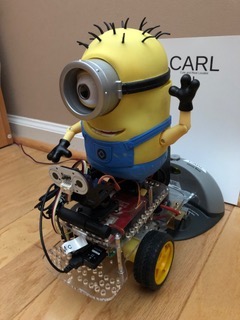GoPiGo Robot More Fun Than Facebook’s Robot

Hypothesis: A Modular Robotics / Dexter Industries GoPiGo3 robot with a single Raspberry Pi 3B central processing unit and the PiCamera, should be sufficient to create a fun robot.
Comparative:
Facebook Robot: “Near-perfect point-goal navigation from 2.5 billion frames of experience”[1]
- “even failing 1 out of 100 times is not acceptable in the physical world”
- error might damage robot or surroundings
- learns to navigate without a map
- “maps become outdated the moment they are created. Buildings change”
- “no scope for mistakes of any kind – no wrong turn …, no exploration”
- agent learns to exploit statistical regularities in real indoor environments
- distributed GPU processes, collectors (simulated actors with sensors)
- 2.5B steps or 80 years experience
- three days wall clock using 64 GPU each having 10K fps processing ability
- 90% success in 1 day with 8 GPU processed 100M steps
- RGB-D imagery with compass and GPS
- Cost? Probably over $100K
- Note: RGB-D without GPS and compass failed at 100M steps, 16% success at 2.5B
- Success is defined as “near-perfect point-goal navigation”
.
.
Suggested GoPiGo Fun Robot Principles:
- Mistakes are expected and tolerated
- Building does not change (quickly)
- Everything is an estimate
- There is no deadline
- Use what you have available
- Learn Environment Map from images
- Parameterize map using encoder data
- Increase trust/adjust with ToF Distance Sensor and IMU
- Increase trust with multiple measurements over time
- Learn Calibrations (Image, Encoders, ToF Distance Sensor, IMU)
- Motivation for map is to allow exploration beyond sight of recharge dock
- Map and exploration are actually much less important than human interaction
- Cost? around $250-$350 (GoPiGo3, Raspberry Pi, PiCam, Battery and Charger)
[ToF Distance Sensor, Servo Kit, IMU] - Success: “robot is fun”
.
.
GoPiGo Pertinent Parameters:
Raspberry Pi 3B:
- CPU 4x Cortex-A53 64-bit 1.2GHz
- GPU 28.8 GFLOPS
- RAM 1GB shared CPU/GPU memory
.
.
Power System:
- 9.6v nominal rechargeable battery provides 1 to 8 hour “life segments”
.
.
References:
[1] https://ai.facebook.com/blog/near-perfect-point-goal-navigation-from-25-billion-frames-of-experience/